Sodium Ion Battery Market Size
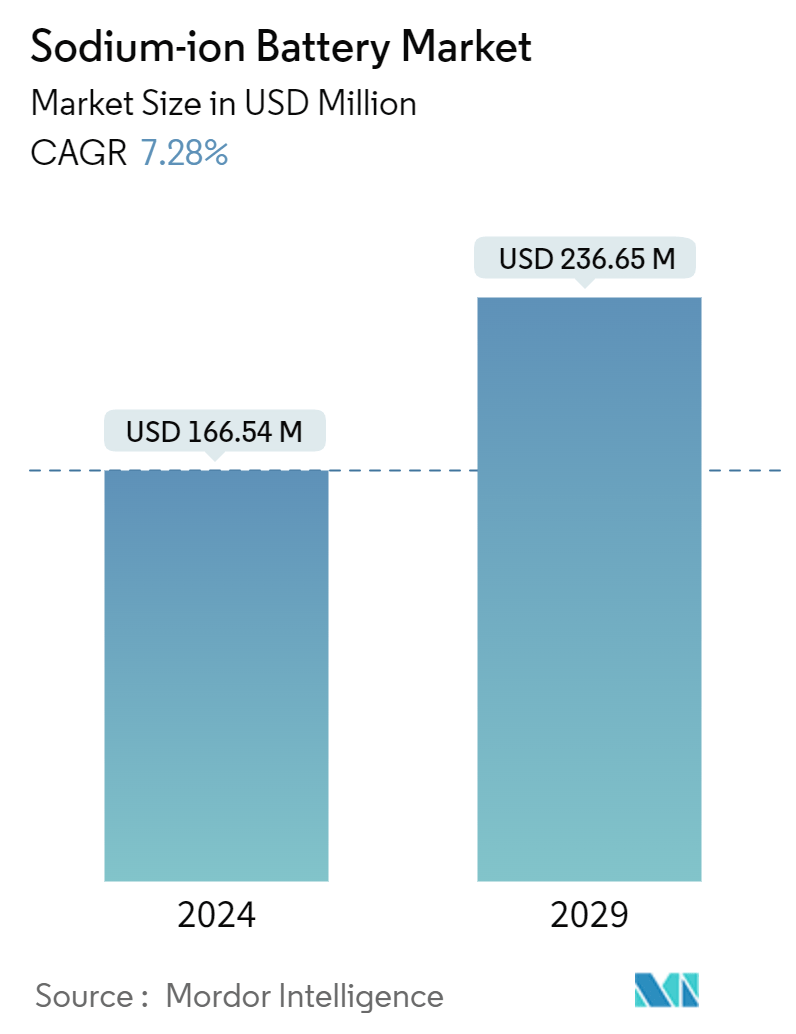
| Study Period | 2020 - 2029 |
| Market Size (2024) | USD 166.54 Million |
| Market Size (2029) | USD 236.65 Million |
| CAGR (2024 - 2029) | 7.28 % |
| Fastest Growing Market | Asia Pacific |
| Largest Market | Europe |
Major Players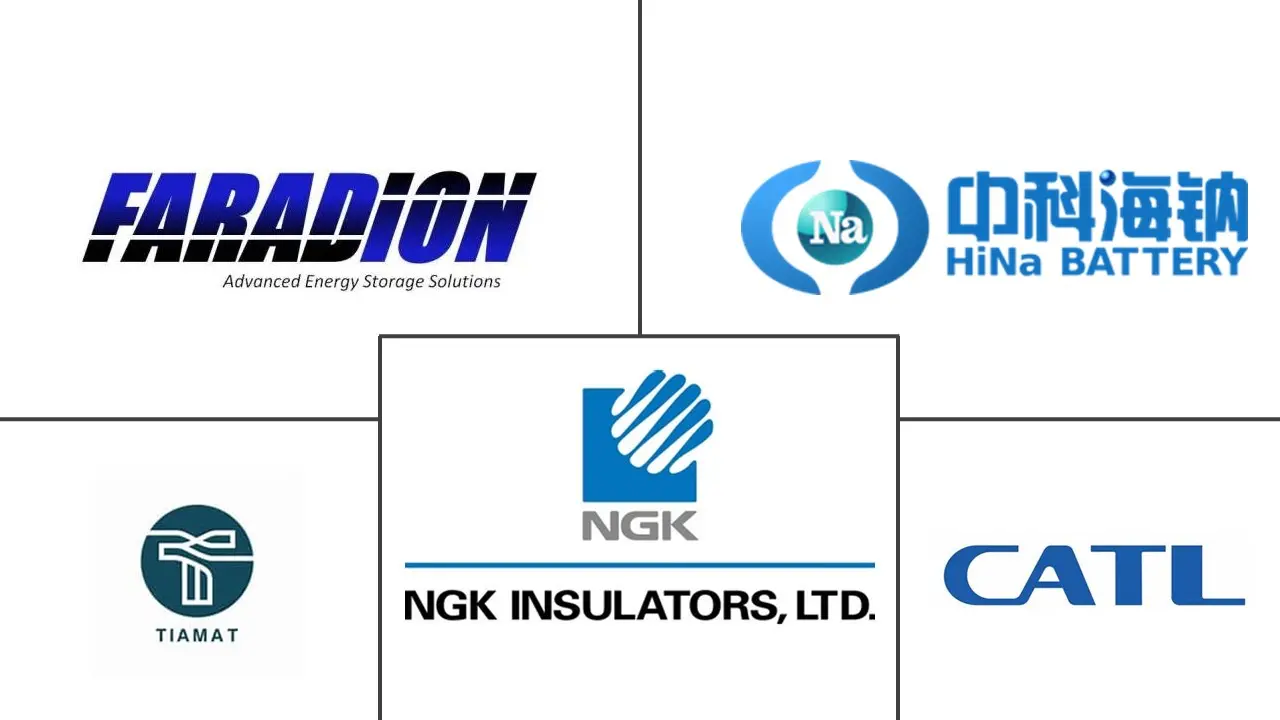
*Disclaimer: Major Players sorted in no particular order |
Sodium Ion Battery Market Analysis
The Sodium-ion Battery Market size is estimated at USD 166.54 million in 2024, and is expected to reach USD 236.65 million by 2029, growing at a CAGR of 7.28% during the forecast period (2024-2029).
- Over the medium period, the primary driver of the market is the increasing demand for cleaner energy, with rising greenhouse gas emissions around the world. Additionally, using sodium-ion batteries for electricity storage, generated through solar or wind, is likely to drive the market.
- On the other hand, the non-matured technology of the storm is expected to hinder market growth during the forecast period.
- Nevertheless, wind and solar PV power are expected to drive strong growth in renewable energy, while hydro is likely to remain a key source. By 2030, solar and wind are expected to produce more than 50% of the total generation in Australia, Germany, Mexico, and the United Kingdom. By 2050, solar PV, wind, and hydro are estimated to produce approximately 80% of the global electricity generation. As sodium-ion batteries are an alternative with additional benefits, storing the energy of solar and wind, they are expected to have an opportunity in the growing solar and wind energy market.
- Europe is expected to dominate the market, with the majority of companies commercializing the battery technology being located in the region. Moreover, with the rising renewable energy generation, such as wind and solar, the region is expected to dominate the market during the forecast period.
Sodium Ion Battery Market Trends
Stationary Energy Storage is a Significant Segment for the Market
- Batteries are crucial in energy storage systems and are responsible for a significant portion of the system's total cost, especially in residential energy storage systems. Properties of sodium-ion batteries, such as high energy density, low charging time, a higher number of charging cycles, etc., make it preferable for this application.
- Sodium-ion batteries are also a viable means of energy storage in large-scale energy storage applications. This is mainly due to the low cost of sodium compared to lithium, similar chemistry, and intercalation kinetics to that of lithium, and the irreversible capacity of carbon anodes in sodium-ion batteries being less than that in lithium-ion batteries.
- The Sodium-ion batteries are expected to have considerable potential in energy storage system applications during the forecast period. The amount of energy generated by renewable sources such as solar and wind is witnessing massive growth, and energy storage is essential to ensure the continuity of energy supply.
- According to the International Renewable Energy Agency (IRENA), the world’s total installed solar PV capacity reached around 1046.61 GW in 2022, witnessing a 22.38% growth compared to the previous year. Likewise, the global wind installed capacity was more than 898 GW in 2022, recording more than 9% growth compared to 2021.
- Furthermore, renewable energy growth is likely to continue with the increasing support from the government and its ambitious renewable power targets. Moreover, according to the International Energy Agency (IEA), by 2050, solar PV, wind, and hydro are estimated to produce approximately 80% of the global electricity generation.
- As sodium-ion batteries are an essential energy storage technology with additional benefits, storing solar and wind energy is expected to provide a vital opportunity in the growing solar and wind energy market.
- On the other side, the cycling efficiency of sodium-ion batteries is not well-known, mainly because the rate capability obtained from hard carbon anodes is poor.
- However, in early 2020, scientists from Skoltech and the Moscow State University identified the electrochemical reaction associated with charge storage in the anode material for sodium-ion batteries (SIB), a promising class of electrochemical power sources. The findings and the anode manufacturing method developed by the team help bring closer the sodium-ion battery commercialization for stationary energy storage in Russia and beyond.
- Hence, the surging growth in renewable energy generation, the rising number of ongoing research development activities, and investments in sodium-ion batteries for stationary energy storage are expected to drive the market during the forecast period.
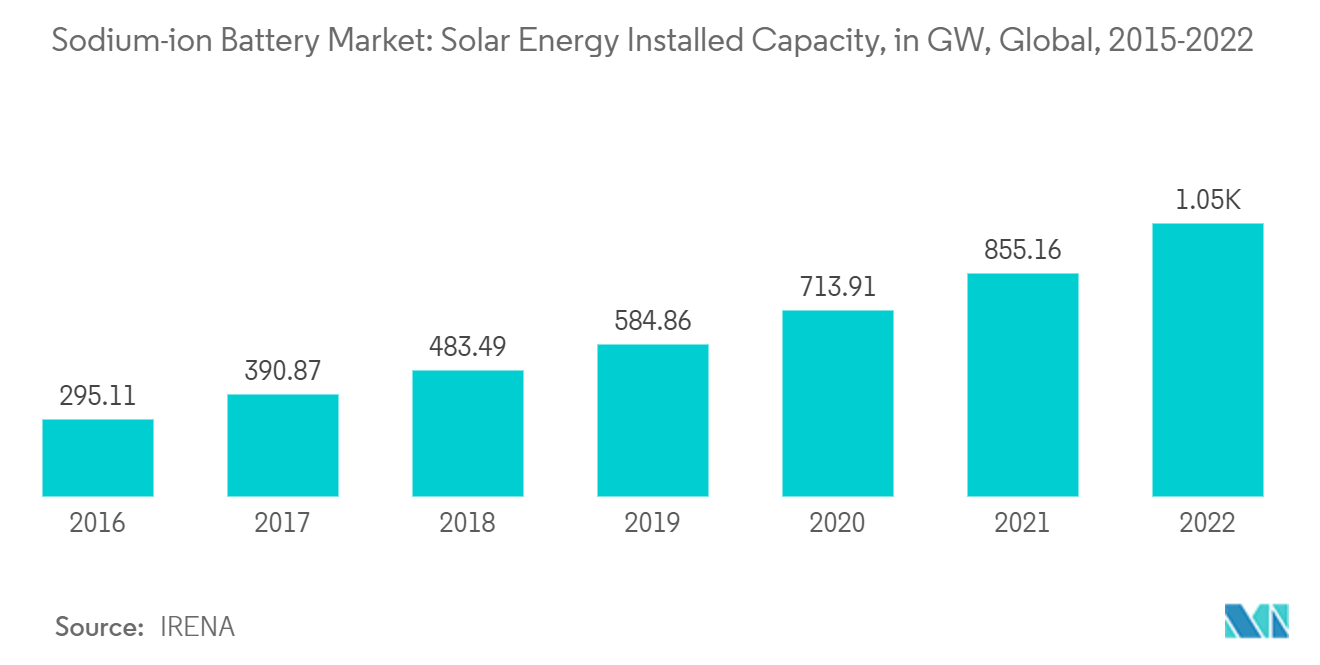
Europe is Expected to Dominate the Market
- In 2022, Europe became the largest region in the sodium-ion battery market owing to the ongoing research and increasing deployment of battery energy storage systems and electric vehicles.
- The new EU-funded project NAIMA, “Na Ion materials as essential components to manufacture robust battery cells for non-automotive applications,” had kickstarted in France. The European Commission awarded this project a Horizon2020 program grant of almost EUR 8 million. The duration of the program is 36 months, which started in December 2019 and ended in December 2022.
- The NAIMA project is expected to demonstrate that two new generations of highly competitive and safe sodium-ion cells developed and tested during the project are some of the most robust and cost-effective alternatives to current and future Li-based technologies for storage applications.
- NAIMA brings together a consortium, including 15 partners from eight European countries (including France, Germany, Sweden, Bulgaria, Spain, the Netherlands, Slovenia, and Belgium): Five being R&D organizations (including CNRS, CEA, NIC, IHE, and VITO), six SMEs (including TIAMAT, BIOKOL, IEIT, GOLDLINE, ACC, and ZABALA IC), and four large companies (including EDF, GESTAMP, SOLVAY, and UMICORE). These partners’ profiles cover the entire battery value chain and the diverse fundamental R&D fields required in the project.
- The project is led by the French company TIAMAT, which specializes in the design, development, and manufacture of sodium-ion battery cells and targets fast charging and high discharge current applications in mobility and stationary storage sectors.
- Within the project framework, six sodium-ion battery prototypes are expected to be tested in three multi-scale business scenarios to provide solid evidence about the competitiveness of the technology in three natural environments (renewable generation, industry, and private household).
- The United Kingdom-based company Faradion Ltd is one of the leading sodium-ion battery manufacturers worldwide. The company is one of the beneficiaries of the United Kingdom government’s USD 338.42 million Faraday battery challenge and is gearing up to supply sodium-ion batteries with an annual capacity of more than 1 GWh by 2024-25, worth more than approximately USD 100 million per year.
- Hence, the ongoing research work, increasing investments, and increasing demand for electric vehicles are expected to create ample opportunities for the players involved in the European region in the near future.
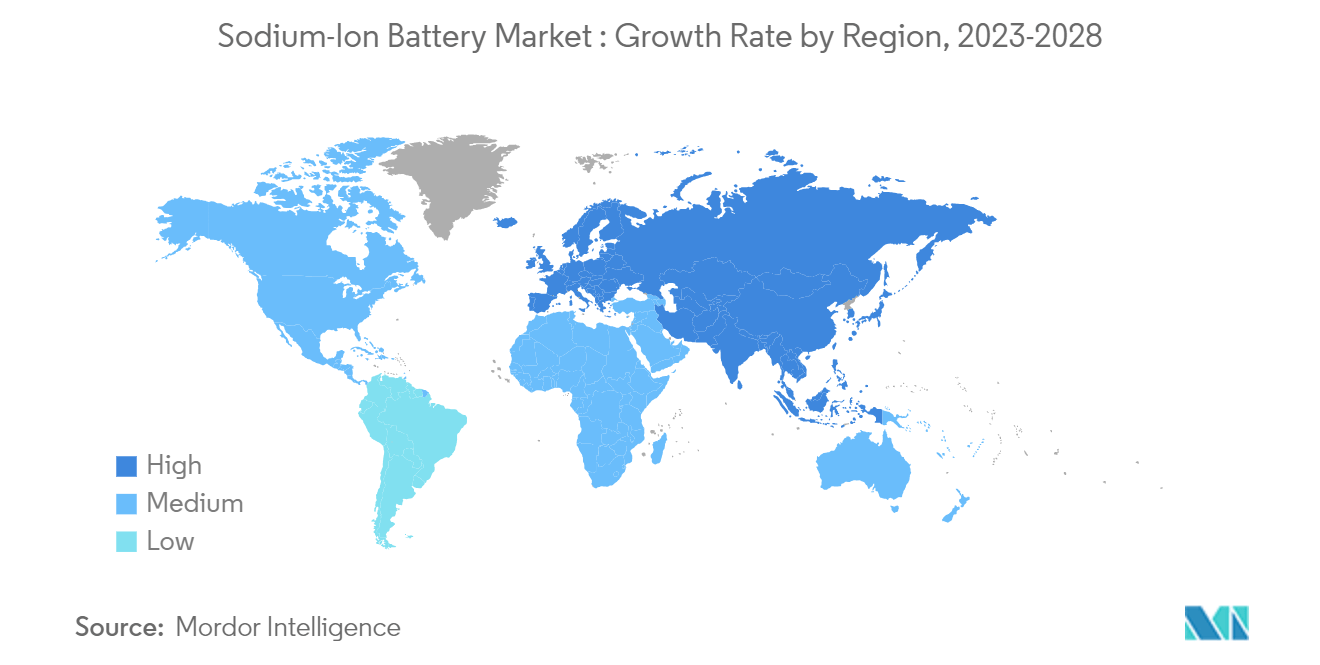
Sodium Ion Battery Industry Overview
The sodium-ion battery market is semi-consolidated. The key players in the market (not in particular order) include Faradion Limited, Contemporary Amperex Technology Co. Limited, NGK Insulators Ltd, TIAMAT SAS, HiNa Battery Technology Co. Ltd, Altris AB, and Natron Energy Inc., among others.
Sodium Ion Battery Market Leaders
-
Faradion Limited
-
AMTE Power PLC
-
NGK Insulators Ltd
-
HiNa Battery Technology Co. Ltd.
-
TIAMAT SAS
-
Contemporary Amperex Technology Co. Limited
-
Altris AB
-
Natron Energy Inc.
*Disclaimer: Major Players sorted in no particular order
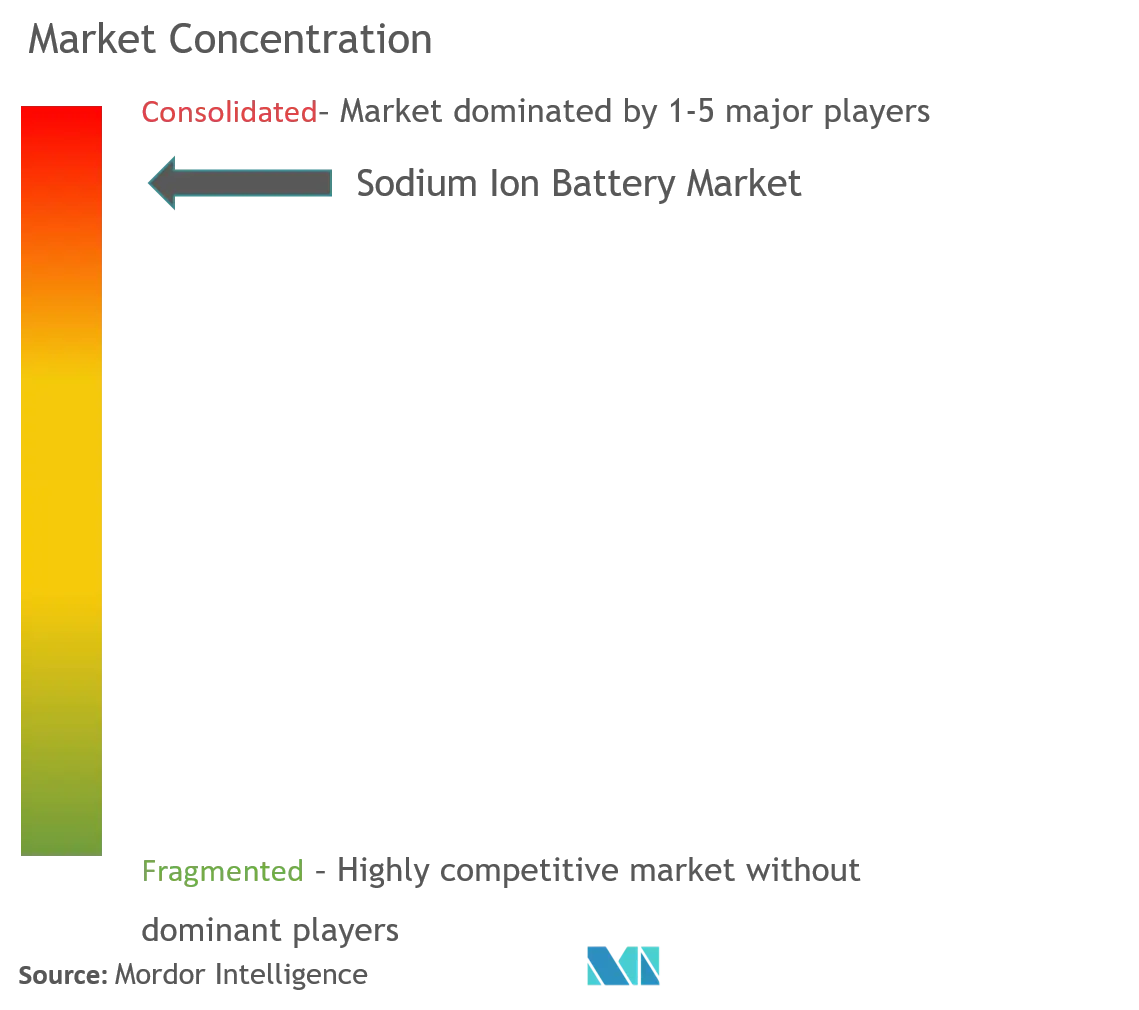
Sodium Ion Battery Market News
- June 2023: FinDreams, the battery division of Chinese automaker BYD, is forming a partnership with Huaihai Holding Group. Together, the two companies announced plans to supply sodium-ion batteries for compact electric vehicles.
- May 2022: Natron Energy, Inc. and Clarios International, Inc. announced a strategic agreement to manufacture sodium-ion batteries. The Clarios International Inc. Meadowbrook facility was expected to become the world’s first mass-produced and largest sodium-ion battery plant when it begins its production in 2023. The plant was to have a production capacity of 600MW by next year.
Sodium Ion Battery Market Report - Table of Contents
1. INTRODUCTION
- 1.1 Scope of the Study
- 1.2 Market Definition
- 1.3 Study Assumptions
2. EXECUTIVE SUMMARY
3. RESEARCH METHODOLOGY
4. MARKET OVERVIEW
- 4.1 Introduction
- 4.2 Market Size and Demand Forecast in USD, till 2028
- 4.3 Recent Trends and Developments
- 4.4 Government Policies and Regulations
-
4.5 Market Dynamics
- 4.5.1 Drivers
- 4.5.1.1 The Increasing Demand for Cleaner Energy
- 4.5.1.2 Increasing Adoption of Sodium-Ion Batteries for Energy Storage Systems
- 4.5.2 Restraints
- 4.5.2.1 Availability of Technical Constraints
- 4.6 Supply Chain Analysis
-
4.7 Porter's Five Forces Analysis
- 4.7.1 Bargaining Power of Suppliers
- 4.7.2 Bargaining Power of Consumers
- 4.7.3 Threat of New Entrants
- 4.7.4 Threat of Substitute Products and Services
- 4.7.5 Intensity of Competitive Rivalry
5. MARKET SEGMENTATION
-
5.1 Application
- 5.1.1 Stationary Energy Storage
- 5.1.2 Transportation
-
5.2 Geography
- 5.2.1 North America
- 5.2.1.1 United States of America
- 5.2.1.2 Canada
- 5.2.1.3 Rest of the North America
- 5.2.2 Europe
- 5.2.2.1 United Kingdom
- 5.2.2.2 Germany
- 5.2.2.3 France
- 5.2.2.4 Italy
- 5.2.2.5 Rest of the Europe
- 5.2.3 Asia-Pacific
- 5.2.3.1 China
- 5.2.3.2 India
- 5.2.3.3 Japan
- 5.2.3.4 Rest of the Asia-Pacific
- 5.2.4 South America
- 5.2.4.1 Brazil
- 5.2.4.2 Argentina
- 5.2.4.3 Rest of the South America
- 5.2.5 Middle-East and Africa
- 5.2.5.1 United Arab Emirates
- 5.2.5.2 Saudi Arabia
- 5.2.5.3 South Africa
- 5.2.5.4 Rest of the Middle-East and Africa
6. COMPETITIVE LANDSCAPE
- 6.1 Mergers and Acquisitions, Joint Ventures, Collaborations, and Agreements
- 6.2 Strategies Adopted by Leading Players
-
6.3 Company Profiles
- 6.3.1 Faradion Limited
- 6.3.2 AMTE Power PLC
- 6.3.3 NGK Insulators Ltd
- 6.3.4 HiNa Battery Technology Co. Ltd.
- 6.3.5 TIAMAT SAS
- 6.3.6 Contemporary Amperex Technology Co. Limited
- 6.3.7 Altris AB
- 6.3.8 Natron Energy Inc.
- *List Not Exhaustive
7. MARKET OPPORTUNITIES AND FUTURE TRENDS
- 7.1 Rising Renewable Energy Targets Across the Regions
Sodium Ion Battery Industry Segmentation
A sodium-ion battery is a viable power storage option because sodium ions serve as a highly active and efficient charge carrier. Some of the characteristics of sodium-ion batteries include their reversibility, good electrochemical properties, and fast response time. In sodium-ion batteries, the primary raw materials include electrolyte material, barrier material, encapsulating material, and separators.
Sodium-ion battery market is segmented into application and geography. By application, the market is segmented into stationary energy storage and transportation. The report also covers the market size and forecasts for the sodium ion battery market across major regions, such as North America, Europe, Asia-Pacific, Middle East, Africa, and South America.
For each segment, the market sizing and forecasts have been done based on revenue (USD).
| Application | Stationary Energy Storage | |
| Transportation | ||
| Geography | North America | United States of America |
| Canada | ||
| Rest of the North America | ||
| Geography | Europe | United Kingdom |
| Germany | ||
| France | ||
| Italy | ||
| Rest of the Europe | ||
| Geography | Asia-Pacific | China |
| India | ||
| Japan | ||
| Rest of the Asia-Pacific | ||
| Geography | South America | Brazil |
| Argentina | ||
| Rest of the South America | ||
| Geography | Middle-East and Africa | United Arab Emirates |
| Saudi Arabia | ||
| South Africa | ||
| Rest of the Middle-East and Africa |
Sodium Ion Battery Market Research FAQs
How big is the Sodium-ion Battery Market?
The Sodium-ion Battery Market size is expected to reach USD 166.54 million in 2024 and grow at a CAGR of 7.28% to reach USD 236.65 million by 2029.
What is the current Sodium-ion Battery Market size?
In 2024, the Sodium-ion Battery Market size is expected to reach USD 166.54 million.
Who are the key players in Sodium-ion Battery Market?
Faradion Limited, AMTE Power PLC, NGK Insulators Ltd, HiNa Battery Technology Co. Ltd., TIAMAT SAS, Contemporary Amperex Technology Co. Limited, Altris AB and Natron Energy Inc. are the major companies operating in the Sodium-ion Battery Market.
Which is the fastest growing region in Sodium-ion Battery Market?
Asia Pacific is estimated to grow at the highest CAGR over the forecast period (2024-2029).
Which region has the biggest share in Sodium-ion Battery Market?
In 2024, the Europe accounts for the largest market share in Sodium-ion Battery Market.
What years does this Sodium-ion Battery Market cover, and what was the market size in 2023?
In 2023, the Sodium-ion Battery Market size was estimated at USD 154.42 million. The report covers the Sodium-ion Battery Market historical market size for years: 2020, 2021, 2022 and 2023. The report also forecasts the Sodium-ion Battery Market size for years: 2024, 2025, 2026, 2027, 2028 and 2029.
What are the drivers of the Sodium Ion Battery Market?
The drivers of the Sodium Ion Battery Market are a) Increased demand for cleaner energy b) Growing demand for electric vehicles
Sodium Ion Battery Industry Report
The global sodium-ion battery market is experiencing significant growth, driven by its high energy efficiency and low manufacturing cost compared to lithium-ion batteries. Sodium-ion batteries are abundant and cheaper, making them a viable option for low-cost electric cars. Despite facing competition from lithium-ion and lead-acid batteries due to their lower energy density, sodium-ion batteries are gaining traction, particularly in the energy storage segment. This growth is fueled by the escalating electricity demand, especially in countries like India and China.
The largest segment within this market is sodium sulfur batteries, attributed to their low manufacturing cost. The Asia Pacific region, with significant contributions from China, Japan, India, and South Korea, is the largest market for sodium-ion batteries. As more players enter the ecosystem, the sodium-ion battery market is anticipated to expand significantly in the coming years.
Industry reports and market data indicate a promising market outlook for sodium-ion batteries. The market forecast suggests continued market growth, driven by the increasing demand for energy storage solutions. Market segmentation shows that stationary energy storage and transportation are the primary applications for sodium-ion batteries. Industry analysis highlights the competitive landscape, with several market leaders emerging in this space.
The market overview provides insights into the industry size and market value, emphasizing the potential for significant market growth. Industry research and market predictions underscore the importance of sodium-ion batteries in meeting future energy demands. Industry trends point to a growing interest in sustainable and cost-effective energy storage solutions, further boosting the market's prospects.
For a detailed market analysis and industry statistics, refer to the report example and report pdf available. Research companies and industry information provide valuable insights into the sodium-ion battery market, helping stakeholders make informed decisions. The industry outlook remains positive, with a focus on innovation and technological advancements driving the market forward.
In summary, the sodium-ion battery market is poised for substantial growth, supported by favorable market trends and a robust industry outlook. The market review highlights the key drivers and challenges, offering a comprehensive understanding of the market dynamics. With continued investment and research, sodium-ion batteries are set to play a crucial role in the future of energy storage and transportation.



